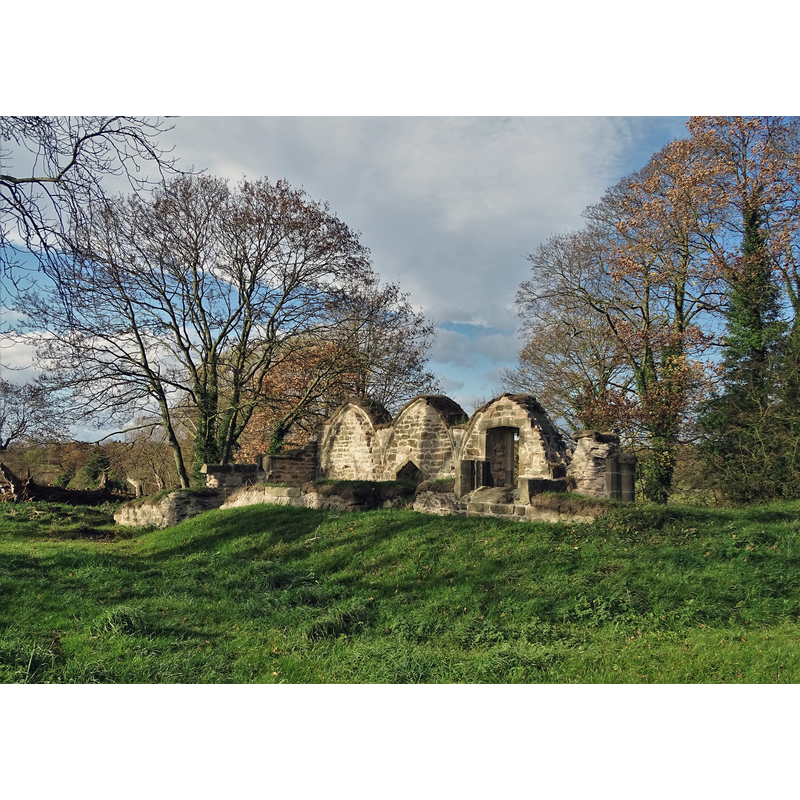Haughton / Haughton Chapel / Hockton / Hoctun

Image copyright © Neil Theasby, 2018
CC-BY-SA-2.0
Results: 1 records
view of church exterior in context
Scene Description: Source caption: "There is clear evidence that remedial work has taken place in recent months to preserve this eleventh century Norman chapel".
Copyright Statement: Image copyright © Neil Theasby, 2018
Image Source: digital photograph taken 13 November 2018 by Neil Theasby [www.geograph.org.uk/photo/5975067] [accessed 6 March 2019]
Copyright Instructions: CC-BY-SA-2.0
INFORMATION
FontID: 09839HAU
Object Type: Baptismal Font1
Church/Chapel: [originally from the Chapel of St. James, now in ruins, in Haughton]
Church Patron Saints: St. James
Church Location: [coordinates are for the old chapel ruins]
Country Name: England
Location: Nottinghamshire, East Midlands
Directions to Site: Both Haughton and Walesby are on the B6387, just a few kms NE of Ollerton
Ecclesiastic Region: Diocese of Southwell & Nottingham
Historical Region: Hundred of Bassetlaw
Font Location in Church: Reported ca. 1930 in the W end of the nave at Haughton St. James', in ruins -- moved to Walesby in 1947
Century and Period: 11th - 12th century, Norman
Font Notes:
Click to view
There is an entry for this Haughton [variant spelling] in the Domesday survey [https://opendomesday.org/place/SK6772/haughton/] [accessed 6 March 2019] but it mentions neither cleric nor church in it. The entry for this township in the Victoria County History (Lancaster, vol. 4, 1911) mentions no early chapel or churdch here. Blagg (1930) reports "a plain circular Norman font, thirty inches in external diameter, lying uncared for at the west end of the nave", in the chapel of St. James, Houghton. According to a local source [not recorded / not available], this early tub-shaped font was moved to nearby Walesby in 1947 [cf. infra]. [NB: Cox (1912) had already reported a Norman tub font at Walesby ca. 1912]. The entry for Haughton in the Southwell & Nottingham Church History Project [http://southwellchurches.nottingham.ac.uk/haughton-chapel/hhistory.php] [accessed 6 March 2019] notes: "Domesday Book does not record either church or personnel of any classification at Haughton. Its cultivable land lay waste and the manor was considerably impoverished. Despite this assessment in 1086, the chapel’s early Norman south doorway, adjacent herringbone masonry and unadorned tub font, suggest that construction commenced soon afterwards for the purpose of serving a small hamlet. At the present time there is no village in Haughton parish and the chapel ruins are located in solitary isolation. [...] For two hundred and fifty years the chapel remained as part of the Newcastle Estate, but unused and irrelevant it slowly fell into ruin. A faculty was granted in 1825 for ‘The removal of loose stone from Haughton chapel’ and informal ‘tidying up’ was carried out in the 1970s. The font and recumbent effigy were removed to Walesby church in 1947, but the locations of other artefacts noted in 1931 have not been identified. [...] the chancel arch collapsed in 1949, and the building was declared unsafe [...] no action was taken to stabilise the substantial ruins then standing, and they have since collapsed. [...] In 2003 the dimensions of St James’ Chapel can be discerned by dwarf sections of walling among the fallen masonry. Still in situ is the blocked up arcading with stone, doorway and windows possibly recycled from former use in the once existing aisle, and under one arch, exposed by more recent disintegration, coloured medieval decorative artwork." The web site of the Walesby Parish Council [www.walesby.org/content/history/haughton/haughton-chapel-ruins/] [accessed 6 March 2019] notes: "Since 1257 the chapel , dedicated to St James, has been link to the parish church of St Edmunds in Walesby. Until recently 2 fonts from the chapel, as was a gravestone, lay in the churchyard in Walesby. The fonts were Norman with one possibly being of the late Saxon period."
COORDINATES
Church Latitude & Longitude Decimal: 53.24819, -0.9615
Church Latitude & Longitude DMS: 53° 14′ 53.48″ N, 0° 57′ 41.4″ W
UTM: 30U 636011 5901819
MEDIUM AND MEASUREMENTS
Material: stone
Number of Pieces: one
Font Shape: tub-shaped (round)
Basin Interior Shape: round
Basin Exterior Shape: round
Diameter (includes rim): 75 cm [approx.]
Notes on Measurements: Blagg (1930) [given as 30"]
REFERENCES
Blagg, T.M., "Haughton Chapel", 35 (1930), Transactions of the Thoroton Society, 1930, pp. [?]; [?]
Cox, John Charles, Nottinghamshire, London: Allen, 1912